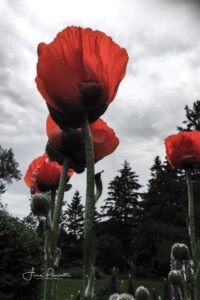by Fiona Plunkett
South Mountain resident
2nd Vice President, Public Relations Officer, and Band Liaison
Royal Canadian Legion, Branch 212, Kemptville
 As you may have noticed last week, volunteers were scattered across the region with poppy boxes. Most of us wear them every year. Most of us have a collection of poppies from previous years in corners of our homes. Most of us have heard of In Flanders Fields (originally titled They Shall Not Sleep) and can recite at least some of the poem. But do you know the history behind the poppy, as a symbol of remembrance?
As you may have noticed last week, volunteers were scattered across the region with poppy boxes. Most of us wear them every year. Most of us have a collection of poppies from previous years in corners of our homes. Most of us have heard of In Flanders Fields (originally titled They Shall Not Sleep) and can recite at least some of the poem. But do you know the history behind the poppy, as a symbol of remembrance?
The poppy is the most enduring symbol of the First World War and Armistice (Remembrance) Day. Very few things grew in the churned up soil of the Western Front. In fact, they flourished in the chalk, soil, and lime, and their beauty stood out against the devastation of the land. They inspired Canadian Surgeon, Lieutenant-Colonel John McCrae, to write the famous poem in 1915 which is now read around the world.
Moved and inspired by McCrae’s poem, two women began advocating for the poppy to be adopted as the official symbol of Remembrance.
Madame Anna Guérin, born in France, moved to England in 1911, and then to the United States when the First World War broke out. By 1920, she was responsible for Poppy Days in a number of states. She travelled to England and with her experience in fundraising and women’s groups, she advocated for (and offered to fund) one million poppies made in France. The British Legion announced that November 11 would be known as Poppy Day, and commissioned an additional eight million to be manufactured in England.
American professor and humanitarian Moina Michael penned her response entitled We Shall Keep The Faith in 1918, and also began her mission to make the poppy the official symbol of remembrance in the United States.
In 1921, the Royal British Legion, the Great War Veterans’ Association (from which the Royal Canadian Legion was formed) and the American Legion Auxiliary began wearing the poppy on their left lapels, closest to their hearts, in order to remember the sacrifice of soldiers in times of war.





